Korean beef is a flavorful tender cut of meat that is a staple in Korean cuisine. It is usually marinated in a sweet and savory sauce then grilled or pan-fried. The complex flavors of Korean beef make it a standout main dish. However, the right side dishes can take your Korean beef to the next level.
Complementing your Korean beef with the perfect sides is key. The sides should balance out the sweet and salty flavors of the beef, add color and crunch, and round out the meal. After scouring blogs and Korean cookbooks, I’ve compiled this list of 15 delicious side dish ideas to serve with Korean beef.
Spicy Cucumber Salad
Cucumber salad is a light and refreshing banchan, or Korean side dish, that goes perfectly with grilled meats. For this spicy cucumber salad, thinly sliced cucumbers are tossed in a dressing of rice vinegar, soy sauce, sesame oil, garlic, and gochugaru (Korean red pepper flakes). The cool crunchy cucumbers balance out the sweet, savory Korean beef. Their mild flavor also cuts through the spice from the gochugaru. This easy salad takes just 10 minutes to prepare, making it an ideal weeknight side.
Kimchi Fried Rice
For a heartier side dish, you can’t go wrong with kimchi fried rice To make this flavor packed fried rice, cook up a batch of white rice Then sauté some kimchi, bacon, carrots, peas, and eggs in sesame oil. Add the rice and toss everything together. The smoky bacon and spicy kimchi pair perfectly with the umami Korean beef. The crunchy veggies add great texture contrast. Kimchi fried rice is also a great way to use up leftover rice.
Korean Green Salad
A simple Korean green salad offers color and crunch alongside the rich Korean beef. Build the salad on a bed of lettuce or cabbage Top with julienned apples, cucumbers, carrots, and red onion Make a tangy soy-vinegar dressing spiked with sesame oil and toasted sesame seeds. The crisp cool vegetables and bright dressing cut through the hearty beef. It’s an easy salad to whip up with veggies you likely have on hand.
Broccoli with Sesame Sauce
Broccoli sautéed in a sweet and nutty sesame sauce is another excellent banchan for Korean beef. Simply blanch broccoli florets until tender-crisp. Then sauté them in a sauce of soy sauce, sugar, sesame oil, and toasted sesame seeds. The broccoli’s mild flavor won’t compete with the beef. And the sesame sauce’s nuttiness complements the sweet-salty marinade. Heart-healthy broccoli also balances the richer beef.
Spicy Radish Salad
For a banchan with some kick, spicy radish salad is just the thing. Korean radishes or daikon radishes are shredded then dressed in a spicy blend of gochugaru, garlic, fish sauce, vinegar, and sugar. The crisp pungent radishes hold their own next to the bold beef. Their peppery bite balances the sweetness of the beef marinade. It’s an addictive quick pickle that can be made ahead of time.
Braised Potatoes
Savory braised potatoes are an easy, satisfying side for Korean beef. Simply boil potato chunks until fork tender. Then sauté them in butter, olive oil, and woody herbs like rosemary and thyme. The creamy potatoes offer comforting contrast to the salty-sweet beef. They also help sop up the tasty juices. Braised potatoes couldn’t be simpler to make, but lend richness to the plate.
Asian Pear Salad
For a fruit-based side, turn to this bright Asian pear salad. Thinly slice Asian pears and toss them with red onion, cilantro, lime juice, fish sauce, and chili flakes. The sweet juicy pears balance the hearty beef. They also add refreshing crunch and brightness. Feel free to substitute another crisp fruit like apples or jicama if you can’t find Asian pears. This no-cook salad comes together quickly.
Eggplant Banchan
Korean eggplant side dishes, or gapjang, are savory-sweet and caramelized. Try pan frying eggplant rounds until golden brown and tender. Then drizzle them with a syrupy sauce of soy sauce, mirin, garlic, and sesame oil. The meaty eggplant holds up well to the robust beef. And its subtle sweetness mirrors the beef’s marinade. Crispy edges adds nice texture against the tender beef too.
Zucchini Pancakes
To add a crispy element, serve zucchini pancakes with Korean beef. Grate zucchini and wring out excess moisture. Combine it with egg, flour, green onions, and salt. Then pan fry spoonfuls like little veggie pancakes. These moreish zucchini pancakes offer great crunch and flavor contrast. Their mild taste lets the marinated beef shine. Make extras because they reheat beautifully.
Glass Noodles with Vegetables
For a light noodle side, try seasoned glass noodles tossed with shredded vegetables. Soak sweet potato starch noodles to soften them. Then mix with julienned carrots, spinach, cabbage, mushrooms, and soy sauce. The chewy noodles provide substance alongside the beef, while the vegetables add nutrition. Drizzle them with some sesame oil to echo the beef’s nuttiness. This veggie noodle dish feels fresh but satisfying.
Steamed Egg Custard
Fluffy steamed egg custard, or gyeranjjim, makes a soothing complement to Korean beef’s robustness. Beat together eggs, dashi stock, soy sauce, and minced scallions. Steam the custard in a bowl until just set. Then top it with the beef and extra scallions. The soft creamy egg custard balances the textures of the meal. Its purity also highlights the beef’s flavor. Kids and adults alike will love this comforting, protein-packed side.
Stuffed Peppers
For a heartier meal, serve colorful stuffed peppers alongside your Korean beef. Stuff hollowed bell pepper halves with cooked rice, ground meat, kimchi, mushrooms, and cheese. Bake until the filling is hot and the peppers soften. The sweet peppers contrast nicely with the salty-sweet beef. Theirtexture also offsets the tender meat. Stuff them ahead of time for an easy side to pop in the oven.
Pickled Daikon Radish
Quick pickled daikon radish, or danmuji, offers crunchy tang to complement Korean beef. Julienne daikon and soak it briefly in salty water to remove bitterness. Drain and dress it with rice vinegar, sugar, garlic, and chile flakes. Chill for just 20 minutes before serving. The pickled radishes cut through the rich beef with their crisp texture and sour zing. Their simplicity also lets the star ingredient shine.
Seaweed Rice Rolls
For an easy no-cook side, roll up rice and vegetables in dried seaweed sheets. Lay a sheet of gim or nori on a sushi mat. Spread with cooked rice, shredded carrots, cucumbers, and spinach leaves. Roll it up into a long cylinder, moistening the sheet so it sticks. Then slice into rounds. These seaweed rice rolls offer great color, crunch, and a hit of salty ocean flavor to balance the beef. Kids love assembling and eating them too.
Fried Tofu
Crispy pan-fried tofu lends protein and texture contrast to a Korean beef meal. Simply dredge cubed firm tofu in cornstarch, then fry in vegetable oil until golden. Toss the crispy fried tofu in a quick garlic-soy-sesame glaze. The tofu’s mild flavor soaks up the sauce beautifully. Its crisp exterior contrasts the tender beef too. Fried tofu couldn’t be easier to whip up with just a few ingredients.

1 – Spicy Cucumber Salad
I probably should have saved my favorite for last, but why not start off with a bang? This Spicy Cucumber Salad (Oi Muchim, 오이무침) is the bomb! Crispy cucumbers, spicy pepper flakes, and nutty sesame oil…it’s a good combo.
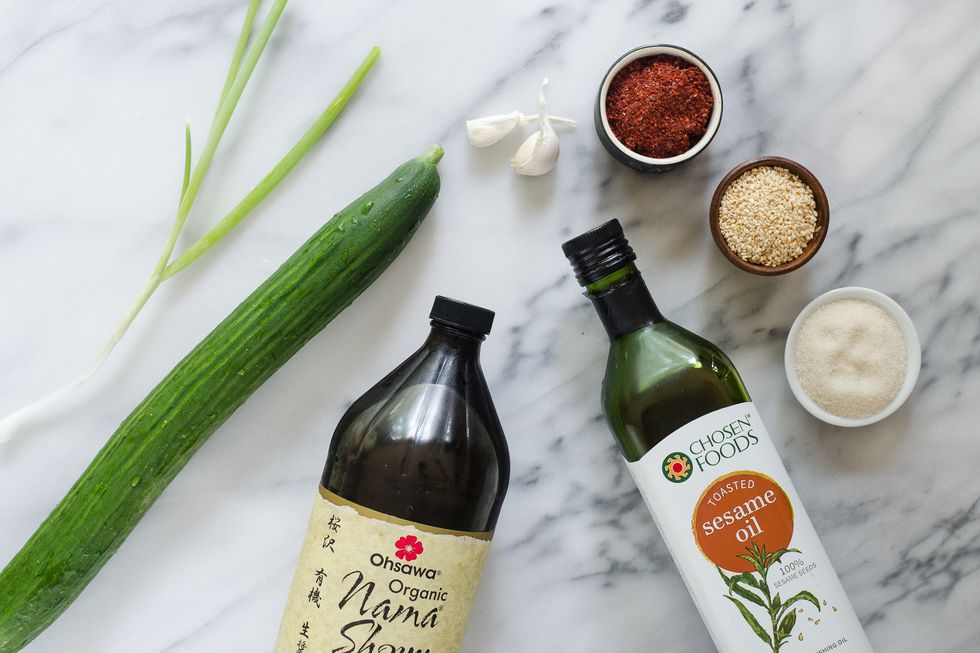
Here’s everything you’ll need: an English cucumber, green onion, garlic, gochugaru, toasted sesame seeds, sugar, toasted sesame oil, and soy sauce.
You’ll notice that many ingredients are repeated over and over in different side dish recipes. Garlic, green onions, sesame seeds, toasted sesame oil, and gochugaru (Korean red pepper flakes) are very common. My biggest tip for the best flavor is to make sure you buy toasted sesame oil. When I first started making Korean food I used regular sesame oil, and the flavor just wasn’t there!
Also, English cucumbers aren’t completely authentic, but locating an actual Korean cucumber can be difficult. English ones work well, or even regular in a pinch!

Slice up the cucumbers and green onions and mince the garlic. Put everything in a bowl.

Toss together thoroughly. Your hands work great for this job, but you could use a fork, spoon, tongs, or chopsticks instead.
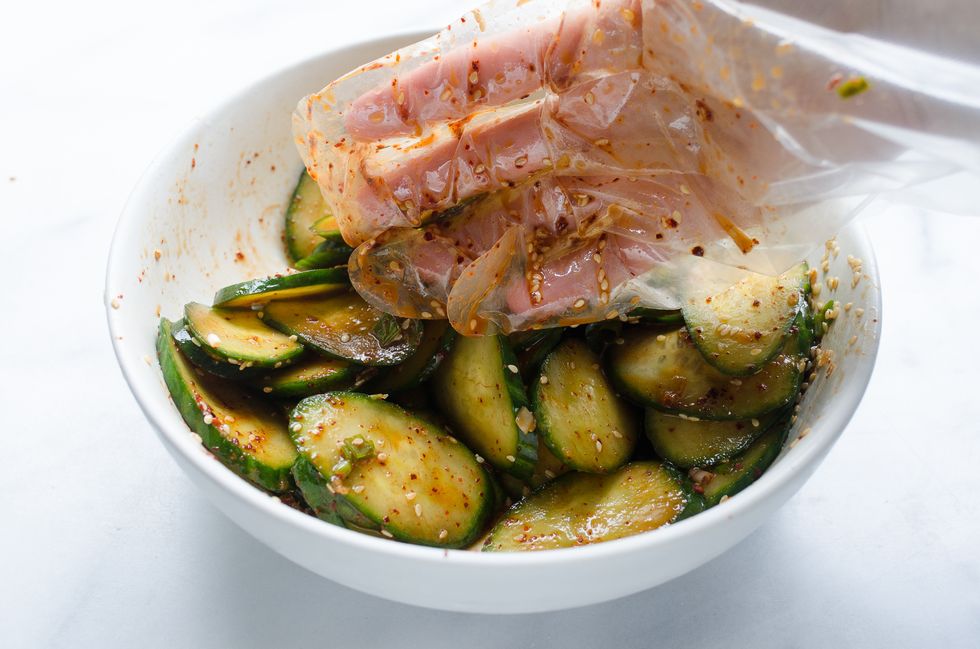
A glove isn’t necessary for hand mixing, but it prevents stains from the gochugaru.
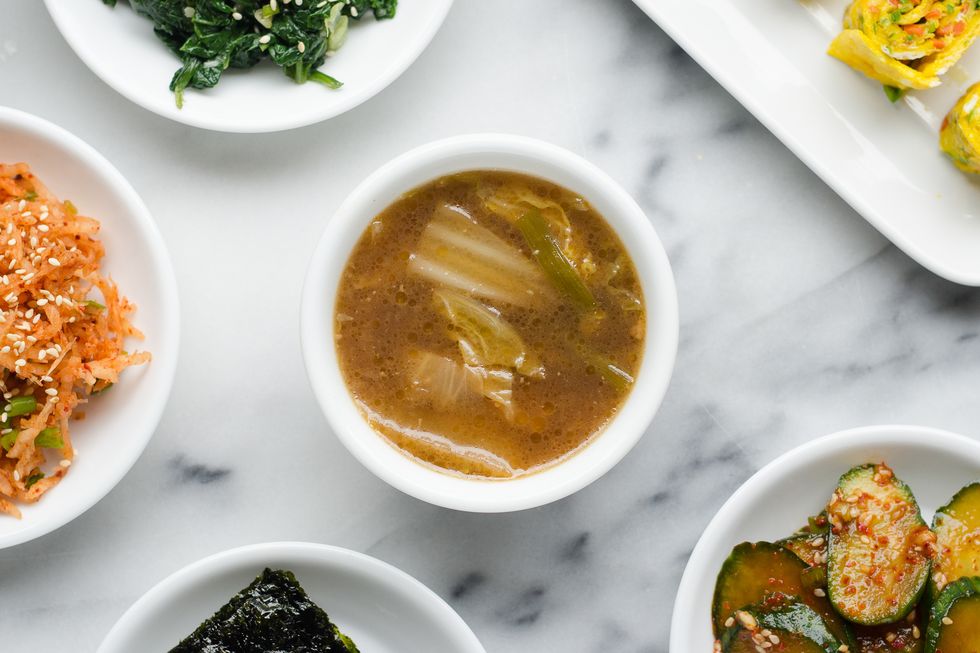
3 – Spicy Radish Salad
This Spicy Radish Salad (Mu Saeng Chae, 무생채) is probably my second favorite Korean side dish that I’ve made. I didn’t think I would like it as much, but it kind of grows on you. Then you get addicted.
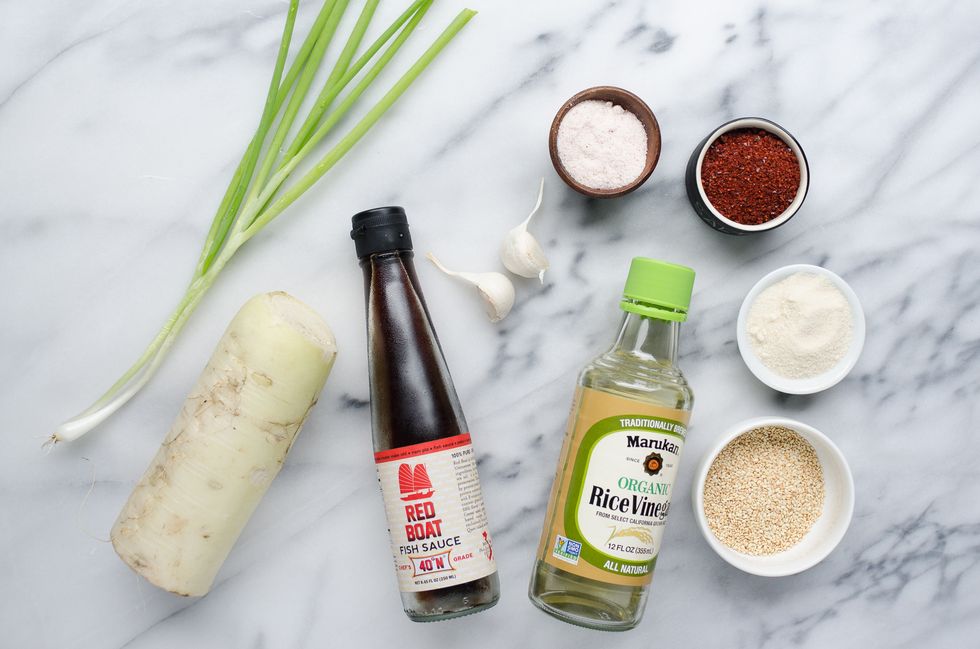
It would be ideal if you could find a Korean radish, but a daikon radish is a good substitute. You’ll also need a green onion, garlic, salt, gochugaru, sugar, sesame seeds, rice vinegar, and fish sauce. If you don’t have or can’t stand fish sauce, you could always leave it out or substitute soy sauce.
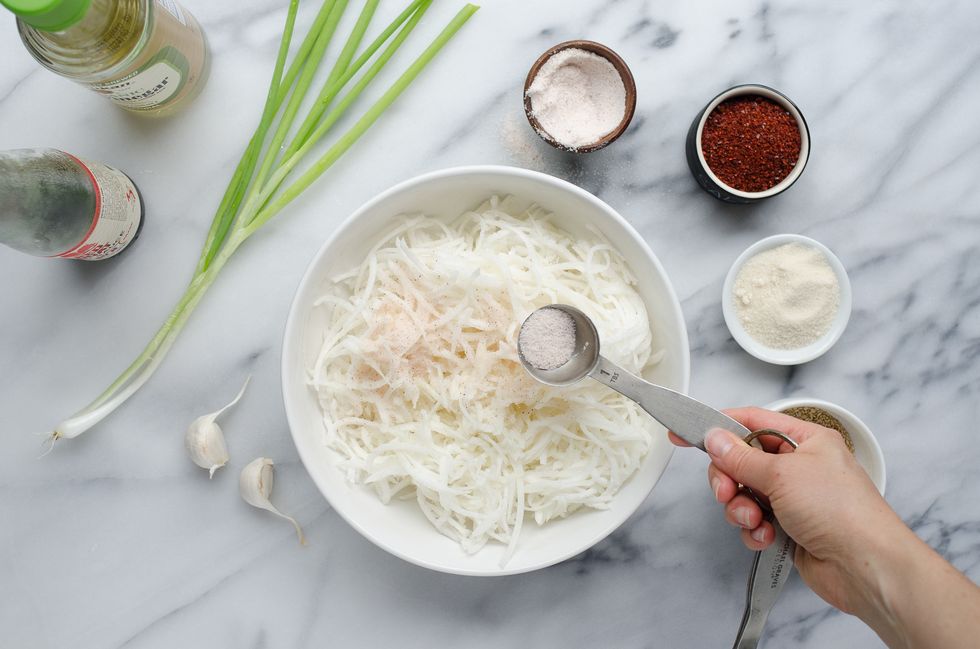
First of all, shred your radish. I like using a food processor for this job.
Sprinkle a tablespoon of salt over the shredded radish and toss to coat. Set aside for 5 minutes.
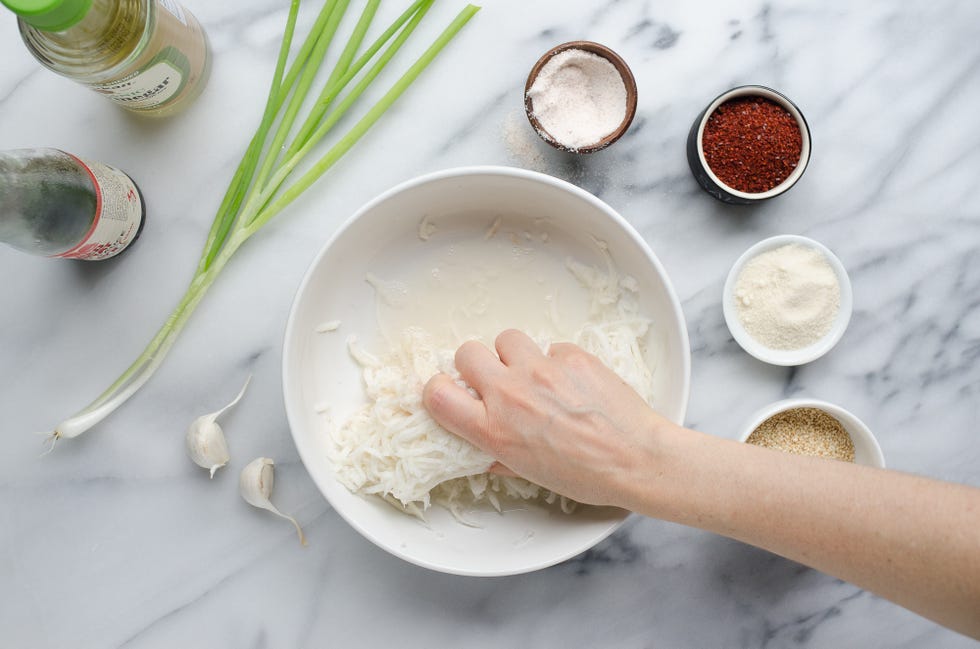
When you come back to the radish, you’ll notice that it has started to sweat. Squeeze it really well to extract most of the liquid. Discard.
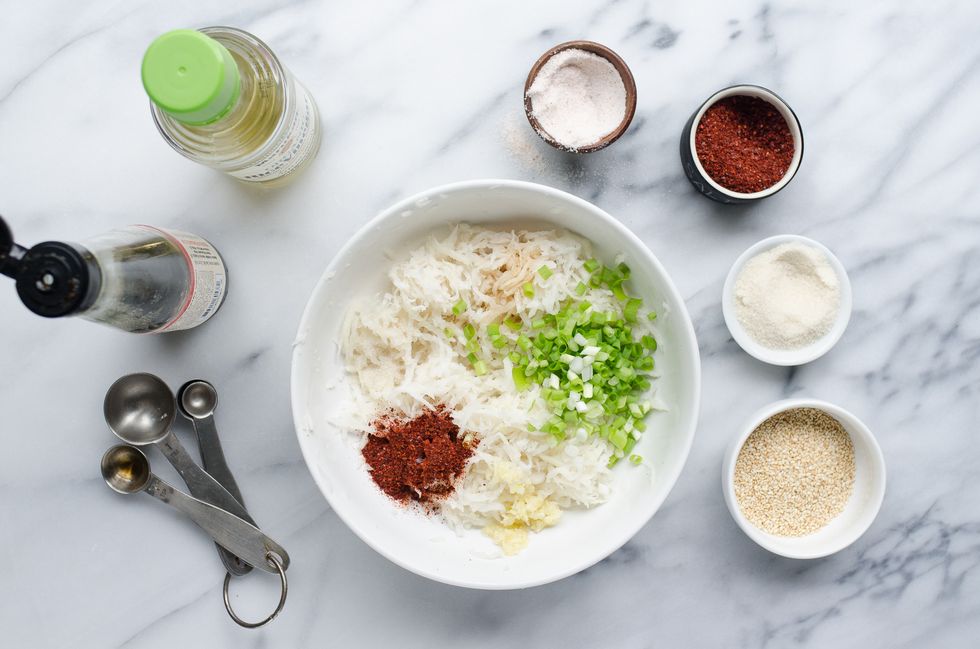
Add the other ingredients to the bowl.

Mix well with your hands or a utensil.
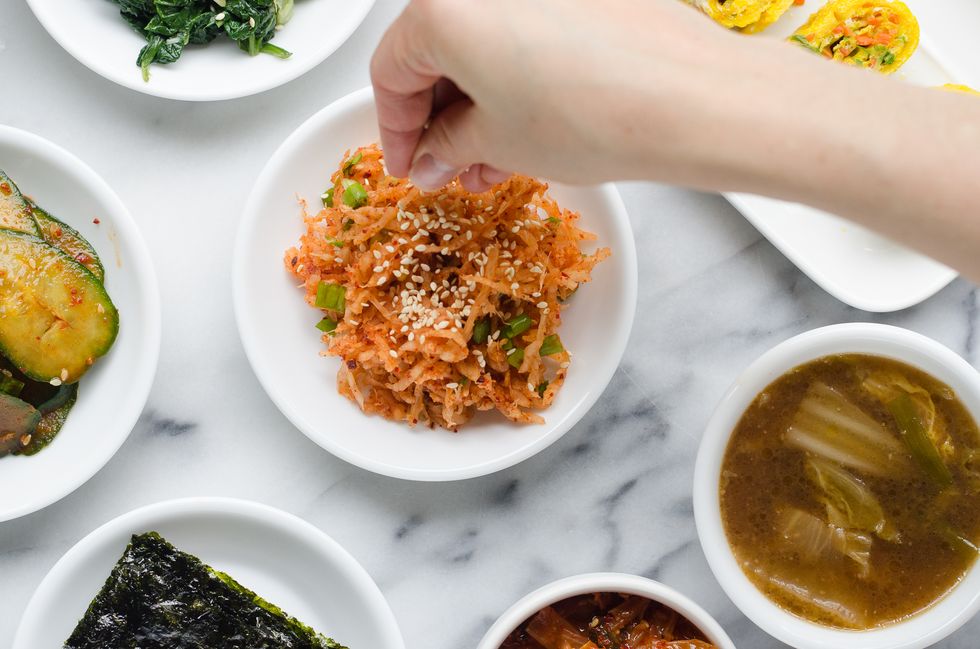
Just before serving, sprinkle some toasted sesame seeds on top.
I wish I had a plate of this right now! Yes, I snack on it all by itself…
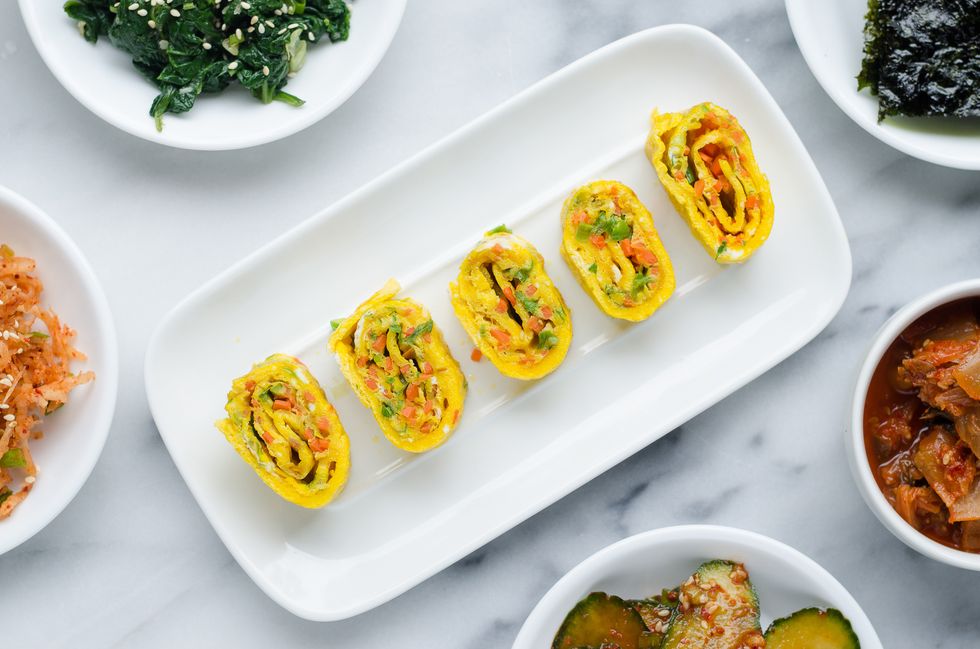
Korean BBQ-Style Beef (Bulgogi)
FAQ
What side dishes go with Korean beef?
- Korean Cucumber Salad (Oi Muchim) …
- Pickled Radish Paper (Ssam-Mu) …
- Pickled Onions (Yangpa Jangajji) …
- Kimchi Recipe (Napa Cabbage Kimchi) …
- Korean Green Salad. …
- Ssamjang Recipe (Korean Dipping Sauce) …
- Korean Macaroni Salad. …
- Easy Dongchimi (Radish Water Kimchi)
What to eat Korean BBQ beef with?
Most recipes call for crushed pear to tenderize the meat. My boyfriend’s Korean mother says Coca-Cola can also be used for the same purpose. This recipe uses very thinly-sliced sirloin steak, so tenderization isn’t necessary. It’s delicious served with rice, lettuce leaves, and chile paste or kimchi.
What are typical Korean side dishes?
- 1 – Spicy Cucumber Salad
- 2 – Cabbage Doenjang Soup
- 3 – Spicy Radish Salad
- 4 – Egg Roll Omelette
- 5 – Spinach Side Dish
What side dishes go with Korean beef short ribs?
Braised potatoes, pickled daikon, kimchi, spicy cucumbers, quail eggs, marinated bean sprouts. The list goes on and on because they really bring you out UNLIMITED bowls of banchan to go with your meal.
What to eat with Korean beef?
Here’s the short answer. The best side dishes to serve with Korean beef are Korean classics like kimchi fried rice, soybean sprouts, japchae, spicy cucumber salad, and Korean braised potatoes. For something different, serve pickled vegetables. Try roasted sweet potato wedges or mashed cauliflower if you want to try fusion. Ready?
Does Korean beef need a side dish?
If you’re making Korean beef, then you might be thinking that it doesn’t need a side dish. After all, isn’t that what rice is for? While plain white rice does go great with this meal, I have found that having some interesting sides makes it even more delicious.
What are the best side dishes for Korean barbecue?
While the main dish might be the star of the show, side dishes are often used to complement the meal. Serving side dishes is a great way to add variety to the meal and make it interesting. Some of the best side dishes for Korean barbecue include anything that contrasts with the main dish. This means pairing it with a spicy or sweet dish.
Why should you serve a side dish with Korean BBQ?
One of the main reasons for serving a side dish with Korean BBQ is because it helps to balance out the flavours of the meat. The richness of the meat can be quite overpowering, so serving a light and refreshing side dish is essential. Another reason to serve a side dish is because it can help you to make your meal more filling.
